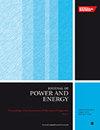Energy and exergy analysis of latent heat storage with heat pipe encased in phase change material
IF 1.1
4区 工程技术
Q3 ENGINEERING, MECHANICAL
Proceedings of the Institution of Mechanical Engineers, Part A: Journal of Power and Energy
Pub Date : 2023-10-31
DOI:10.1177/09576509231212245
引用次数: 0
Abstract
Loop heat pipe (LHP) encased in phase change material (PCM) incorporated annular to catalytic converter (CC) is proposed to augment the performance of the “thermal energy storage” (TES). LHP are designed to extract surplus heat from the exhaust discharge, thereby reducing the amount of exhaust heat emitted into the atmosphere. A four-cylinder IC engine’s CC is considered with Mg 70 Zn 24.9 Al 5.1 , paraffin oil as PCM and working fluid for the heat pipe are evaluated. A comparative experimental investigation was performed considering two models for CC with and without heat pipe integrated in the TES for (i) distribution of average PCM temperature (ii) energy, exergy efficiency and distribution (iii) effectiveness (iv) instantaneous waste heat recovered during heat storage. Transient cycles at 2000 r/min with varying load conditions were run considering city drive conditions. Heat storage for CC with heat pipe encased in TES was found to be 35% faster, whereas discharge time for CC without heat pipe developed in TES was found to be longer. For melt fraction 1, maximum exergy efficiencies of 71% and 69% were observed for the TES unit with and without heat pipe. Heat pipes are observed to help extract a considerable amount of surplus heat from exhaust and reduce the exhaust gas outlet temperature released into the atmosphere by nearly 130 – 40°C under various load circumstances.相变材料热管潜热蓄热的能量和火用分析
为了提高“热能储存”(TES)的性能,提出了一种采用相变材料(PCM)包裹的环形热管(LHP),并结合了环形催化转化器(CC)。LHP的设计目的是从废气排放中提取余热,从而减少排放到大气中的废热量。以mg70 Zn 24.9 Al 5.1,石蜡油为PCM,热管工质为工质,对某四缸内燃机的CC进行了评价。对比实验研究考虑了在TES中集成热管和不集成热管的两种CC模型(i) PCM平均温度分布(ii)能量、能源效率和分布(iii)有效性(iv)蓄热过程中回收的瞬时余热。考虑城市驱动条件,以2000 r/min的速度运行了不同负载条件下的瞬态循环。发现在TES中装有热管的CC的储热速度快35%,而在TES中没有开发热管的CC的放电时间更长。对于熔体分数1,有热管和没有热管的TES装置的最大火用效率分别为71%和69%。观察到热管有助于从排气中提取相当数量的余热,并在各种负载情况下将排放到大气中的排气出口温度降低近130 - 40°C。
本文章由计算机程序翻译,如有差异,请以英文原文为准。
求助全文
约1分钟内获得全文
求助全文
来源期刊

CiteScore
3.30
自引率
5.90%
发文量
114
审稿时长
5.4 months
期刊介绍:
The Journal of Power and Energy, Part A of the Proceedings of the Institution of Mechanical Engineers, is dedicated to publishing peer-reviewed papers of high scientific quality on all aspects of the technology of energy conversion systems.
 求助内容:
求助内容: 应助结果提醒方式:
应助结果提醒方式:


